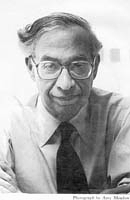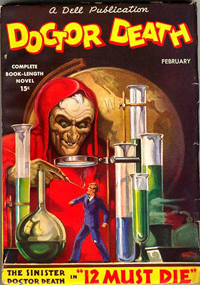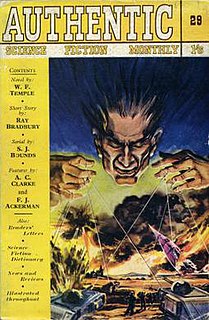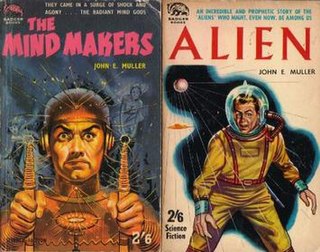
Donald Allen Wollheim was an American science fiction editor, publisher, writer, and fan. As an author, he published under his own name as well as under pseudonyms, including David Grinnell, Martin Pearson, and Darrell G. Raynor.
Pulp magazines were inexpensive fiction magazines that were published from 1896 to the late 1950s. The term "pulp" derives from the cheap wood pulp paper on which the magazines were printed. In contrast, magazines printed on higher-quality paper were called "glossies" or "slicks". The typical pulp magazine had 128 pages; it was 7 inches (18 cm) wide by 10 inches (25 cm) high, and 0.5 inches (1.3 cm) thick, with ragged, untrimmed edges.

Mystery is a fiction genre where the nature of an event, usually a murder or other crime, remains mysterious until the end of the story. Often within a closed circle of suspects, each suspect is usually provided with a credible motive and a reasonable opportunity for committing the crime. The central character is often a detective, who eventually solves the mystery by logical deduction from facts presented to the reader. Some mystery books are non-fiction. Mystery fiction can be detective stories in which the emphasis is on the puzzle or suspense element and its logical solution such as a whodunit. Mystery fiction can be contrasted with hardboiled detective stories, which focus on action and gritty realism.

Ace Books is a publisher of science fiction (SF) and fantasy books founded in New York City in 1952 by Aaron A. Wyn. It began as a genre publisher of mysteries and westerns, and soon branched out into other genres, publishing its first science fiction title in 1953. This was successful, and science fiction titles outnumbered both mysteries and westerns within a few years. Other genres also made an appearance, including nonfiction, gothic novels, media tie-in novelizations, and romances. Ace became known for the tête-bêche binding format used for many of its early books, although it did not originate the format. Most of the early titles were published in this "Ace Double" format, and Ace continued to issue books in varied genres, bound tête-bêche, until 1973.

Robert Lionel Fanthorpe, FCollP, FRSA, FCMI is a retired British priest and entertainer. Fanthorpe also worked as a dental technician, journalist, teacher, television presenter, author and lecturer. Born in Dereham in Norfolk, he lives in Cardiff in South Wales, where he served as Director of Media Studies and tutor/lecturer in Religious Studies.

Lesbian pulp fiction is a genre of lesbian literature that refers to any mid-20th century paperback novel or pulp magazine with overtly lesbian themes and content. Lesbian pulp fiction was published in the 1950s and 60s by many of the same paperback publishing houses as other genres of fiction including westerns, romances, and detective fiction. Because very little other literature was available for and about lesbians at this time, quite often these books were the only reference the public had for modeling what lesbians were. Stephanie Foote, from the University of Illinois commented on the importance of lesbian pulp novels to the lesbian identity prior to the rise of organized feminism: "Pulps have been understood as signs of a secret history of readers, and they have been valued because they have been read. The more they are read, the more they are valued, and the more they are read, the closer the relationship between the very act of circulation and reading and the construction of a lesbian community becomes...Characters use the reading of novels as a way to understand that they are not alone."
Jove Books, formerly known as Pyramid Books, is an American paperback and eBook publishing imprint, founded as an independent paperback house in 1949 by Almat Magazine Publishers. The company was sold to the Walter Reade Organization in the late 1960s. It was acquired in 1974 by Harcourt Brace which renamed it to Jove in 1977 and continued the line as an imprint. In 1979, they sold it to The Putnam Berkley Group, which is now part of the Penguin Group.
Lancer Books was a publisher of paperback books founded by Irwin Stein and Walter Zacharius that operated from 1961 through 1973. While it published stories of a number of genres, it was noted most for its science fiction and fantasy, particularly its series of Robert E. Howard's Conan the Barbarian tales, the first publication of many in paperback format. It published the controversial novel Candy by Terry Southern and Mason Hoffenberg, and Ted Mark's ribald series The Man from O.R.G.Y. Lancer paperbacks had a distinctive appearance, many bearing mauve or green page edging.

Doctor Death was the title of a short-lived pulp science fiction magazine published by Dell Magazines in 1935, as well as the name of the main character featured in that magazine. Doctor Death was an archcriminal who wanted to return the world to a primitive condition and used supernatural tools such as zombies and magic in his plots against humanity. The stories were written by Harold Ward under the pseudonym of "Zorro". Dell may have intended Doctor Death to be a continuation of a character of the same name in All Detective Magazine, also published by Dell.

Gertrude Barrows Bennett, known by the pseudonym Francis Stevens, was a pioneering author of fantasy and science fiction. Bennett wrote a number of fantasies between 1917 and 1923 and has been called "the woman who invented dark fantasy".

Authentic Science Fiction was a British science fiction magazine published in the 1950s that ran for 85 issues under three editors: Gordon Landsborough, H.J. Campbell, and E.C. Tubb. The magazine was published by Hamilton and Co. in London and began in 1951 as a series of novels appearing every two weeks; by the summer it became a monthly magazine, with readers' letters and an editorial page, though fiction content was still restricted to a single novel. In 1952 short fiction began to appear alongside the novels, and within two more years it completed the transformation into a science fiction magazine.
John Stephen Glasby was a prolific author born in East Retford in Nottinghamshire whose work spanned a range of popular genres. A professional research chemist and mathematician, he produced more than 300 novels and short stories during the 1950s and 1960s, most of which were published under pen names by the Badger Books imprint.

Typewriter in the Sky is a science fantasy novel by American writer L. Ron Hubbard. The protagonist Mike de Wolf finds himself inside the story of his friend Horace Hackett's book. He must survive conflict on the high seas in the Caribbean during the 17th century, before eventually returning to his native New York City. Each time a significant event occurs to the protagonist in the story he hears the sounds of a typewriter in the sky. At the story's conclusion, de Wolf wonders if he is still a character in someone else's story. The work was first published in a two-part serial format in 1940 in Unknown Fantasy Fiction. It was twice published as a combined book with Hubbard's work Fear. In 1995 Bridge Publications re-released the work along with an audio edition.
French science fiction is a substantial genre of French literature. It remains an active and productive genre which has evolved in conjunction with anglophone science fiction and other French and international literature.
Horwitz Publications is an Australian publisher primarily known for its publication of popular and pulp fiction. Established in 1920 in Sydney, Australia by Israel and Ruth Horwitz, the company was a family-owned and -run business until the early 21st century. The company is most associated with their son Stanley Horwitz, who took over publishing operations in 1956. Stanley was eventually succeeded by his son Peter and daughter Susan, who was the company's director in the years 1987-2016.

Dynamic Science Fiction was an American pulp magazine which published six issues from December 1952 to January 1954. It was a companion to Future Science Fiction, and like that magazine was edited by Robert W. Lowndes and published by Columbia Publications. Stories that appeared in its pages include "The Duplicated Man" by Lowndes and James Blish, and "The Possessed" by Arthur C. Clarke. It was launched at the end of the pulp era, and when publisher Louis Silberkleit converted Future to a digest format in 1954, he decided not to do the same with Dynamic, simply cancelling the magazine.

Marvel Science Stories was an American pulp magazine that ran for a total of fifteen issues in two separate runs, both edited by Robert O. Erisman. The publisher for the first run was Postal Publications, and the second run was published by Western Publishing; both companies were owned by Abraham and Martin Goodman. The first issue was dated August 1938, and carried stories with more sexual content than was usual for the genre, including several stories by Henry Kuttner, under his own name and also under pseudonyms. Reaction was generally negative, with one reader referring to Kuttner's story "The Time Trap" as "trash". This was the first of several titles featuring the word "Marvel", and Marvel Comics came from the same stable in the following year.

Wonder Story Annual was a science fiction pulp magazine which was launched in 1950 by Standard Magazines. It was created as a vehicle to reprint stories from early issues of Wonder Stories, Startling Stories, and Wonder Stories Quarterly, which were owned by the same publisher. It lasted for four issues, succumbing in 1953 to competition from the growing market for paperback science fiction. Reprinted stories included Twice in Time, by Manly Wade Wellman, and "The Brain-Stealers of Mars", by John W. Campbell.

Amazing Stories Quarterly was a U.S. science fiction pulp magazine that was published between 1928 and 1934. It was launched by Hugo Gernsback as a companion to his Amazing Stories, the first science fiction magazine, which had begun publishing in April 1926. Amazing Stories had been successful enough for Gernsback to try a single issue of an Amazing Stories Annual in 1927, which had sold well, and he decided to follow it up with a quarterly magazine. The first issue of Amazing Stories Quarterly was dated Winter 1928 and carried a reprint of the 1899 version of H.G. Wells' When the Sleeper Wakes. Gernsback's policy of running a novel in each issue was popular with his readership, though the choice of Wells' novel was less so. Over the next five issues, only one more reprint appeared: Gernsback's own novel Ralph 124C 41+, in the Winter 1929 issue. Gernsback went bankrupt in early 1929, and lost control of both Amazing Stories and Amazing Stories Quarterly; associate editor T. O'Conor Sloane then took over as editor. The magazine began to run into financial difficulties in 1932, and the schedule became irregular; the last issue was dated Fall 1934.
In the 1950s, British firm John Spencer & Co. published four science fiction magazines in digest format: Futuristic Science Stories, Worlds of Fantasy, Tales of Tomorrow, and Wonders of the Spaceways. All were launched between April 1950 and February 1951. Maurice Nahum and Samuel Assael, who ran John Spencer, co-edited three of the titles; Assael was the sole editor for Tales of Tomorrow except for the second issue, which Nahum again co-edited. The magazines were of very poor quality; Mike Ashley, a historian of science fiction, describes them as "containing the worst science fiction ever published".













